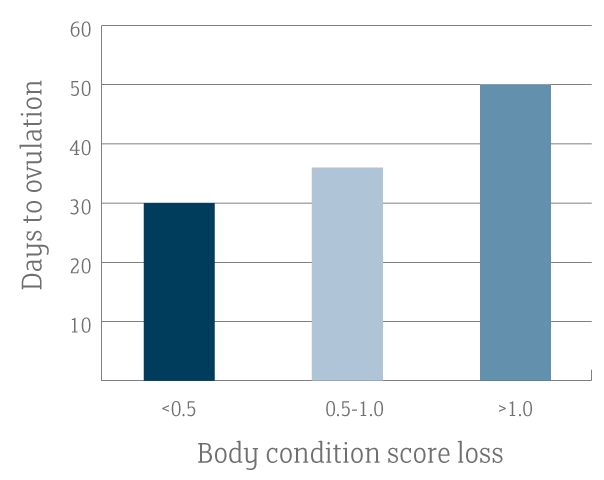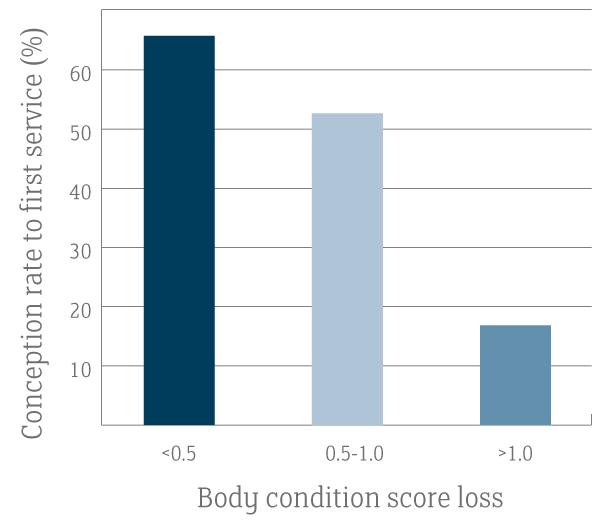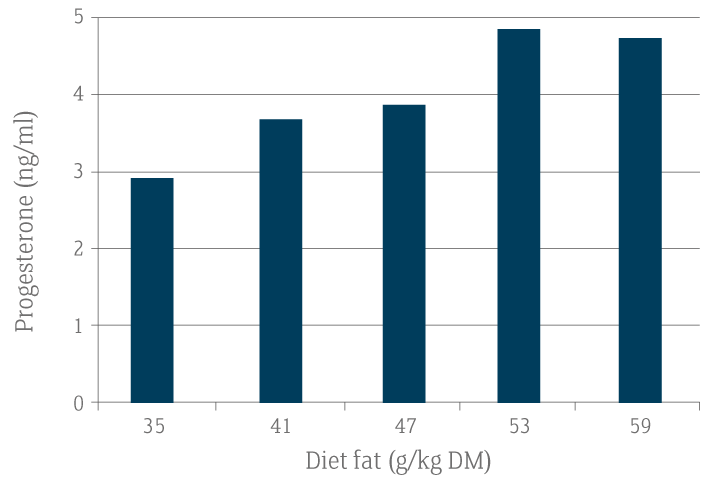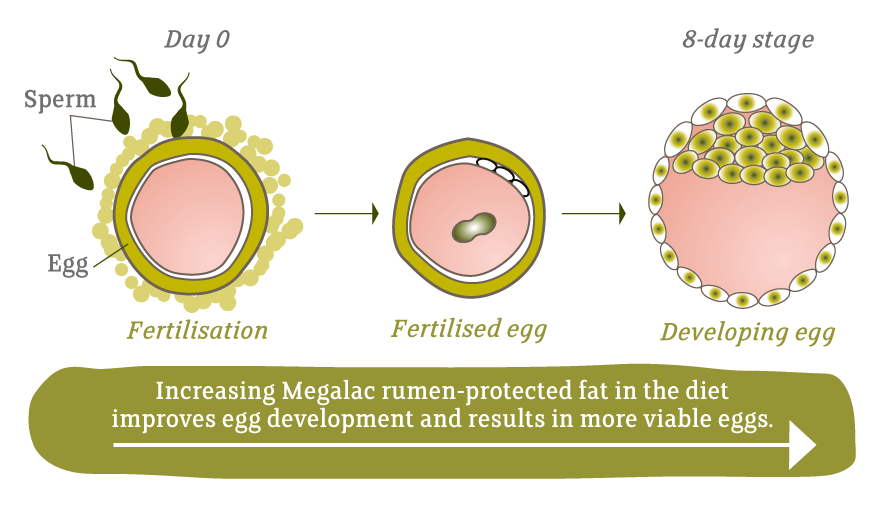Fat and fertility
Supplying sufficient fat in the diet is essential to help maintain fertility in animals. Fat can influence fertility in several ways reflecting the unique benefits of fat as a nutrient source as highlighted below.
Energy balance effects
Fat is the most energy dense nutrient available and is often added to diets to increase energy density. This is particularly beneficial to cows in early lactation where dry matter intake is limited and adding fat is a common method of increasing energy supply (more energy per bite) to help meet the requirements of the cow and reduce body fat mobilisation (losing body condition).
There is a well-proven relationship between cow fertility and body condition score. Cows losing body weight / condition (‘negative energy balance’) take longer to return to cycling after calving (Figure 1; Butler, 2001) and it is well-established that the sooner a cow begins cycling after calving the more likely she is to become pregnant at the subsequent service. Figure 1 Effect of body condition score loss in early lactation on days to ovulation
Figure 1 Effect of body condition score loss in early lactation on days to ovulation
Similarly, negative energy balance has a major detrimental effect on conception rate (Figure 2; Butler and Smith, 1989). As a guideline, conception rate decreases by 10% for each 0.5 unit loss of body condition (5-point scale).
Figure 2 Effect of body condition score loss in early lactation on conception rate to first service
Hormonal (progesterone) effects
Fat supplies the building blocks for the production of progesterone (the hormone of pregnancy) which is essential to maintain the developing embryo. Insufficient progesterone results in embryo death and pregnancy failure. It is estimated that up to 55 % of embryos die in early gestation (Staples et al., 1998) and inadequate progesterone is a major cause of this loss; Irish data indicate that around 25% of cows don’t get back in calf solely due to insufficient progesterone (Morris and Diskin, 2007).
Increasing fat concentration in diets is an effective method of increasing progesterone in blood plasma to support pregnancy, an effect demonstrated clearly in work from the University of Nottingham (UK) (Garnsworthy et al., 2008). In this study, total diet fat was increased from 3.5 to 5.9% (achieved through addition of Megalac up to 660 g at the highest level) (Figure 3). This likely reflects the increased synthesis of cholesterol to facilitate transport of fat around the body as lipoproteins and cholesterol esters, thereby providing cholesterol – the precursor of progesterone – to the ovaries.

Figure 3 Increasing progesterone production with increasing dietary fat from Megalac
Egg quality
Adding fats to diets can improve development of eggs, leading to higher quality, more viable eggs. Detailed work at the University of Nottingham (UK) (Fouladi-Nashta et al., 2007) reported a significantly higher proportion of in vitro-fertilised eggs developed to the blastocyst stage (around 8-days after fertilization; Figure 4) when cows had been offered a high fat diet (containing 800 g of Megalac rumen-protected fat) compared to cows offered a lower fat diet (click here for further details). Increased development to the blastocyst stage indicates higher quality eggs which are more likely to result in a successful pregnancy.  Figure 4 Development of fertilised eggs to the blastocyst (8-day) stage
Figure 4 Development of fertilised eggs to the blastocyst (8-day) stage
Oleic acid
Recent data indicate benefits to developing eggs from the presence of oleic acid. Research in The Netherlands (Aardema et al., 2011) evaluated the effect of palmitic (C16:0), stearic (C18:0) and oleic (C18:1) acids on oocyte developmental competence post-fertilisation and reported that while C16:0 and C18:0 had a detrimental effect on oocyte development, C18:1 increased it. These data indicate that both the concentration and ratio of saturated and unsaturated fatty acids in follicular fluid can affect the development of oocytes and overall fertility.
Volac Wilmar’s Megalac contains a high proportion of C18:1 fatty acids in rumen-protected form, facilitating delivery of C18:1 to the small intestine and uptake by tissues.
Omega-3 and omega-6 fatty acids
Omega-3 and omega-6 are essential fatty acids (i.e. they must be supplied in the diet) which play a key role in fertility. Following fertilisation, pregnancy is maintained by production of progesterone from the corpus luteum on the ovary, which requires production of PGF2α (stimulated by omega-6 fatty acids) to be reduced. Omega-3 fatty acids compete with omega-6 fatty acids in the series of elongation steps required to produce particular prostaglandins, with omega-3 fatty acids being elongated to series-3 prostaglandins rather than the series-2 prostaglandins typical for omega-6 fatty acids. Hence, omega-3 fatty acids can help maintain the corpus luteum and secure pregnancy by competitive inhibition leading to a reduction in production of PGF2α.
Volac Wilmar’s Mega-Flax product contains omega-3 fatty acids targeted to improve cow fertility where an imbalance in omega-3 and omega-6 fatty acids is leading to poor fertility.